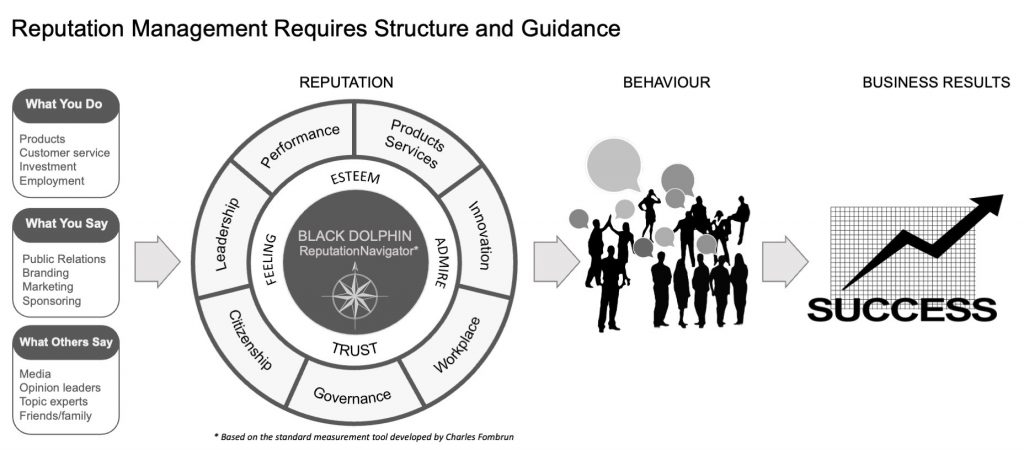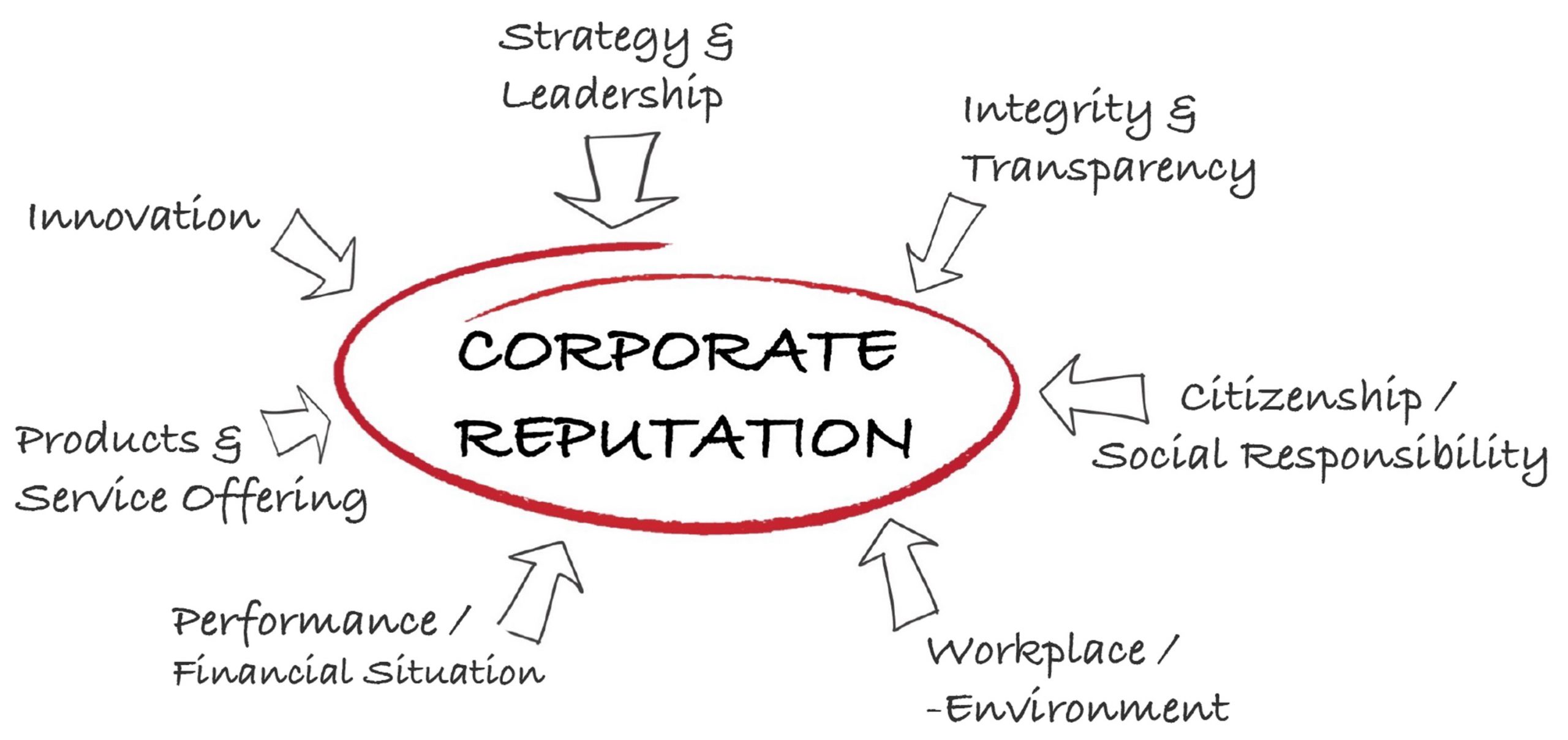Build A Positive Reputation!
If you provide for positive word of mouth, you automatically provide for positive reputation; when people speak well about you, your company and your products in public, you have automatically created a positive reputation. So reputation and word of mouth belong very closely together and even condition each other.
In this blog article I talk about both the reputation outside the internet (in your city, your catchment area or your sphere of influence), but also about the much more complex and difficult to deal with online reputation of your company in the world wide web.
Frequently Asked Questions About Reputation
– What is reputation and why does my company need it?
– How is reputation risk managed and monitored?
– How is reputation built and maintained?
– What influence does reputation have on the value of a company?
– What measures can be taken to build a positive reputation?
– How can I repair damage to a reputation?
What is reputation and why does my company need it?
Before you start building a positive reputation, you need to know what a reputation is in the first place, hence this article first.
There are various widespread ideas of what reputation is, but there is no universally valid business definition of reputation in the literature.
Charles Fombrun’s definition of corporate reputation, focused on the different stakeholder groups, whereby corporate reputation is defined as a collective evaluation of a corporation’s attractiveness to a specific group of stakeholders relative to a reference group of corporations with which a corporation competes for the resources.
We enlarged the definition of reputation in the sense that corporate reputation is the totality of how a company is perceived by its stakeholders, considering past and future aspects. It is an amalgamation of various individual experiences, socio-cultural learnings and cognitive attitudes that build people’s perception of a company, its behaviour, and its impact on their needs.
As we will later see, a positive reputation measures on four important core areas which are trust, esteem, admire, and good feeling as perceived by the company’s stakeholders. Its reputation is built on seven dimensions or facets namely, products/services, innovation, workplace, governance, citizenship, leadership, and performance.
Distinction between corporate reputation and corporate image
Reputation and Image and the management of both is often confused to be the same. We draw a fine line between the since both terms contain different conceptions at their core:
Image is essentially the perception about the organisation and is more generic. Mostly it is the short-term evaluation of an organisation’s communication and its impact on various publics. What the stakeholders think about the brand as a result of the messages disseminated is the image of the brand. Since all stakeholders don’t receive the same or all messages and may also interpret messages differently per their own thought process or in view of the timing, the image of an organisation may vary from time to time and person to person.
Image is more of a result of a concerted effort by the advertising, marketing and branding. Whereas, reputation is considered to be more of a result of consistent communications.

“It takes many good deeds to build a good reputation, and only one bad one to lose it.” It is as Benjamin Franklin already realised almost 300 years ago, reputation is the impression that specific public carries of the organisation by way of social evaluation in the long run. It is the prevailing opinion about the brand, its management, its corporate behaviour and is generally not much altered by singular incidents, news or other individual short term factors – but it can!
Reputation risk – consequences of a loss of reputation
The trust of suppliers, partners and customers, as well as the reputation of a company, are essential for the long-term success and continued existence of a company. Although this is not a new insight, it is becoming increasingly important – especially when a company’s reputation suffers as a result of internal or external events. This can sometimes lead to drastic losses.
For example, a negative investigative press report about a company could lead to a decline in new business and lower revenues. On the other hand, reputational risk can also be the cause of losses in other corporate risk types, just as a loss in another corporate risk type can lead to a loss of reputation. Reputational risk must therefore always be seen in the context of other risk types within a company.
Effective risk management of reputational risks
In the past, risk management of reputational risks was almost exclusively limited to dealing with reputational damage that had already occurred. Many companies complained the reason for this low level of attention the fact that reputational risks are not measurable and can hardly be assessed. However, if a company attaches only little importance to reputational risk and if reputational risk is perceived solely as a consequence of other risk categories, then damage has already occurred. Effective risk management should be both preventive and reactive.
The four components of risk management consist of the processes:
- Identification
- Assessment
- Steering
- Control
In line with quality management, companies need to add reputational risk to their Operational Risk Controlling in an effort to continuously improve their reputational risk management. As risks change over time, continuous monitoring of the main risks in risk management is necessary to ensure transparency about the risk situation. In addition to monitoring the material risks, we include immaterial risks in our communications PDCA process to assess reputational risk comprehensively and clearly document associated processes and communication channels.
How is reputational risk managed and monitored?
So-called Operational Risk Controlling plays a central role in identifying and assessing reputational risks. In order to take targeted control and monitoring measures, you must first define the relevant stakeholders and interest groups. This is done on an individual basis, taking into account the business model, market positioning and industry.
For entrepreneurs, the trust of their customers is an essential business foundation and an important success factor. Fluctuations in trust have an immediate impact on success and earning power of a company.
Effective risk management identifies reputational risks at an early stage and reacts appropriately. To do this, company needs to install appropriate processes that are suitable for identifying any reputational risks at an early stage. However, before you install a system for identifying reputational risks, you must first take a risk inventory of the current risks. Which factors (known as reputation drivers) have the greatest impact on risk? Reputation drivers are industry- and company-specific and vary in how they are communicated to and perceived by the public.
To determine the reputation drivers, we use different methods which are the most appropriate to our respective client companies. We employ stakeholder surveys, interviews, self-assessments, workshops and independent analyses.
How is reputation built and maintained?
Every company is at risk from events that affect its reputation. These events can be of different nature, also called the seven dimensions or facets of reputation.
Protecting the company’s reputation must be incorporated into the company’s processes through appropriate strategies and measures. We help companies e.g. to implement a systematic approach to measures its ability to deliver on stakeholder expectations across the seven key rational dimensions of reputation.
A company that has a strong brand and delivers on expectations across the seven facets will earn support from its stakeholders.
What influence does reputation have on the value of a company?
Managers, academics, and stakeholders often need to compare and contrast corporate reputations across companies and/or over time. Yet corporate reputation is a socially constructed, intangible asset. Thus, not surprisingly, managers, academics, and other stakeholders face several challenges when measuring corporate reputations.
Some scientific studies show that changes in reputation are based on critical media reports and on corporate activities. Corporate value and reputation interact with each other. Reputation has an effect on the value of a company, however investments in reputation-building measures require quite a long period of time before they have a positive effect on the value of a company.
To date, there is no formula to calculate or express the financial value of reputation. In general, however, it can be said that a company with a strong reputation also has a greater asset value, a low leverage ratio, a fairly high return on capital and a high growth rate.
Which measures should you adopt to build a positive reputation?
You now know what reputation is, how to define it and what the consequences can be if you lose your reputation. So, a lot depends on a good company reputation. Therefore, it is astonishing that very few companies bother themselves with reputation and put it lightly at risk. What can an entrepreneur actually do to build a positive reputation?

The most important instruments for a good reputation management
1. complaint management – first and foremost, complaint management means listening. What is being said about your company? Read between the lines, address complaints immediately and answer questions. Seek dialog with your customers and don’t wait for them to approach you. Successful complaint management also consists of asking customers for their opinions, for example through surveys. This process can be extended to your own employees and other stakeholders.
2. customer and employee loyalty – It is up to ten times more expensive to acquire new customers than to retain existing customers and win their loyalty. It’s much the same with employees. In the long run, it is much more profitable and cost efficient for you as an entrepreneur to retain employees – because finding new employees and training them is tedious, time-consuming and expensive. Loyal customers, as well as employees, stand up for their company and thus carry a company message with utter conviction. These loyal customers and employees defend their company in front of others – this also reduces negative comments on rating portals or in forums. After all, ” It takes 20 years to build a reputation and five minutes to ruin it.” (Warren Buffet)
3. search engine optimisation – search engine optimisation (SEO) is about being listed as high as possible with positive entries in a search engine results page (list of results that a search engine returns in response to a specific word or phrase query). Most users assume that the Google ranking is based on other users’experiences. In fact, Google uses web crawlers that scan and index pages. Every page gets rated according to Google’s opinion of its authority and usefulness to the end-user. Then, using an algorithm with over 210 known factors, Google orders them on a search result page. Therefore, appearing higher in the search result pages for a given search query directly means you’re the most relevant and authoritative result for it according to Google. If there are “negative pages” among the top entries, or pages that can damage your reputation, action must be taken to delete, move or edit these pages so that the reputational damage can be averted. We can show you how to do this.
4. social media marketing – social media are very effective for reputation building, but also carry large amounts of risk. Most companies and business leaders have experienced that maintaining an online presence on social media is very time-consuming. Once it has been started, it must be maintained and cared for. If you don’t, your own credibility will suffer very quickly. Social media profiles are excellent brand ambassadors. By publishing their own profile, entrepreneurs communicate that they are open to dialog with customers, and that praise, suggestions as well as criticism a are welcome and will be listened to.
How can I repair damage to my reputation?
What happens if, despite all your attempts to build a positive reputation, you are discredited? For example, you find out by chance that people in town are talking badly about your company. First of all, there is very little you can do about it – even if the criticism is completely made up. However, sometimes it is your own fault, because you have failed to build a strong positive reputation. Getting your reputation back is not easy – the basic requirements are perseverance, patience and determination.
What can you do if your reputation has been damaged?
Step 1 – Analyse damage & seek contact
It is very important to find out as soon as possible when harm has been done to
your reputation. Therefore, always try to find out how people talk about your company on- and off-line. If it turns out that negative or wrong information about you is circulating, contact the person who published it. It might have been of lack of knowledge, or the result of misinformation; but it also could be competitors, angry employees or former employees as well as disappointed customers. If no action is taken, the bad news will circulate quickly, and the damage will be very difficult to repair!
Step 2 – Be quick & regain control
When a customer or employee is sharing a concern online, it must be dealt with swiftly. Social media is becoming a platform for customer and employee concerns, reviews, and complaints. Quickly responding to an issue shows them that you are watching and listening. More importantly, a quick response shows that you care. It also helps you to get in front of the issue and resolve things before they escalate on a public platform.
Step 3 – Be polite & courteous
Respond to specific criticism quickly, professionally and objectively. Try to control the situation and not let it escalate into an online mudslinging. Remember that you are not responding to one person. Your other customers or potential customers will be able to see your responses. Always be respectful, even if the customer review was unfavorable or unfair. If you feel you need to defend yourself, do so in a professional manner. Our advice: always take complicated discussion “off-stage” and out of the spotlight.
Step 4 – Admit mistakes & apologise
Be honest and describe the circumstances of why the reputational damage occurred. If you made a mistake, you made a mistake. The public loves nothing more than a public apology. Be sincere and make sure you don’t sound defiant or defensive.
Step 5 – Create a recovery roadmap
So far, you’ve promised that you’ll make things better. Now it’s time to deliver. Your communications teams should work together to create a systematic recovery roadmap. Whether it’s a press release, an opinion article on your social channels or an ad campaign in the regional newspaper or on Facebook. Be sincere and respectful. E.g. share an interview with your CEO (live, recorded or in print); publishing information provided by your CEO proves that your company takes the issue seriously and is a way to establish positive content and strengthen your reputation.
Conclusion
It is significantly easier to build a positive reputation than to repair a damaged one. Therefore, proper reputation management is indispensable, especially in times of social media and instant sharing of information globally – be that facts or no facts, news or fake news.
Black Dolphin is your reputation management agency with specialists for all communication channels. Our reputation management experts will be happy to make an appointment with you for a personal meeting (on- or off-line) to learn more about your concerns.
Latest Stories

The Power of Purpose
Why is corporate purpose so important? Purpose is about inspiring all stakeholders – investors, employees, customers, etc. – with lasting enthusiasm for the company.

Clubhouse is dead – long live audio!
A year ago, Clubhouse, a voice-based chatroom app, was the hype par excellence; today, activity has dropped off drastically. Its focus on audio was particularly innovative. So, is audio dead? Podcasts are a trend that has been going on for a long time and even though Clubhouse was a hype that ran out of steam, audio will likely develop more traction in the next few years.

